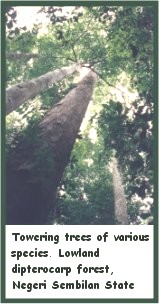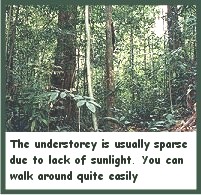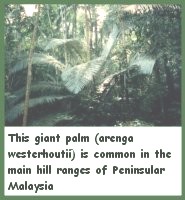
In our region, Malaysia (both Peninsular and East Malaysia) posesses some of the richest and grandest lowland tropical forests to be found anywhere in the world. In fact they may be the richest of all in plant and tree species based on the many scientific studies documenting the flora found at various sites in the tropical regions. A great number of wildlife species are found here too, besides a staggering number of insect species.
 Lowland tropical forests usually have several layers of stratification,
namely the emergant tree layer, main canopy layer, sub-canopy layer, understory
layer, and ground layer consisting of mostly palms, and saplings. In Malaysia,
the lowland forests consists of many trees from the family Dipterocarpacae
and they are known as Tropical Lowland Evergreen Mixed Dipterocarp Rain
Forests (to give their full name!).
Lowland tropical forests usually have several layers of stratification,
namely the emergant tree layer, main canopy layer, sub-canopy layer, understory
layer, and ground layer consisting of mostly palms, and saplings. In Malaysia,
the lowland forests consists of many trees from the family Dipterocarpacae
and they are known as Tropical Lowland Evergreen Mixed Dipterocarp Rain
Forests (to give their full name!).
Lowland forests worldwide generally have a height of 30m and are superficially similar in structure and layout. Here, I'm referring to forests that occur in perhumid zones that display little or no seasonality in rainfall. Generally they receive about 2000mm or more of rain annually and are rich in climbers, epiphytes, and palms. Malaysia's lowland rain forests usually stand at between 40-60m tall (for the emergant layer). The main canopy stands at about 20-30m high. A great number of tree species crowd every hectare (as much as 250 per hectare).
Many dipterocarp trees grow here belonging to genera such as Shorea, Dipterocarpus, Anisoptera, Vatica, Hopea, and Parashorea. Most dipterocarp trees are found in the emergant and main canopy layer, and therefore considered to be dominant trees, hence the name - mixed dipterocarp forests. Dipterocarp trees usually take 70-100 years to reach full maturity. This underscores the difficulty in reforesting and regenerating logged areas. Certainly, very large trees are many hundreds of years old. Besides dipterocarps, trees from the rubber and legume families are also common. Dipterocarp forests are limited to the Sunda Archipelago, and the greatest diversity of dipterocarps occurs in Borneo, about 270 species in all, out of a total of 470 species. Peninsular Malaysia has about 155 species, Sumatra substantially less.
 Malaysia is also the centre for palm biodiversity
in the world and a great many palm species thrive here. Many palm species
in Malaysia have a patchy distribution range, suggesting partial extinction
when conditions such as climate were unfavourable. The potential of Malaysia's
forests to provide pharmaceutical products is very high; however, very
little research work have been done to study plants/trees of medicinal
value to mankind.
Malaysia is also the centre for palm biodiversity
in the world and a great many palm species thrive here. Many palm species
in Malaysia have a patchy distribution range, suggesting partial extinction
when conditions such as climate were unfavourable. The potential of Malaysia's
forests to provide pharmaceutical products is very high; however, very
little research work have been done to study plants/trees of medicinal
value to mankind.
When in the lowland forest, one should look out for the tualang tree (Koompassia excelsa), the tallest tropical broadleaf tree in the world. The record is 84m high, making it one of the tallest trees in the world. It is not found south of an imaginary line linking Kuala Lumpur with Kuantan (a mystery), but is also found in Sumatra and Borneo. The natives believe the tree to be haunted and loggers avoid it because the hard, heavy wood of the tualang tends to shatter when it hits the ground. Also, it's not durable. A cubic foot of tualang wood weighs about 23kg. They shed their leaves between February and April annually (a sign of earlier climactic seasonality in Malaysia?). Wild honey bees often build their nests in the branches of the tree because its smooth bark discourages the Malaysian Sun Bear from climbing up to get at the bees' nests for honey.
Since the hardwood dipterocarp trees are a great source of valuable timber, much lowland forests have been logged and much more cleared for agriculture. Very little undisturbed virgin lowland forests now remain, the only area of any reasonable extent in Malaysia being Taman Negara. The rain forests are here to remind us of how great the potential for life is on our planet Earth and enrich us with their biodiversity.